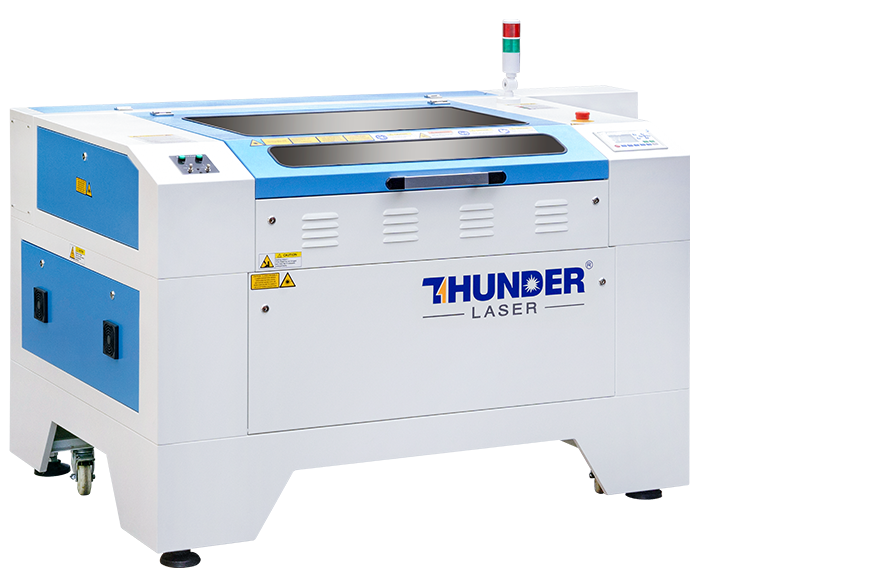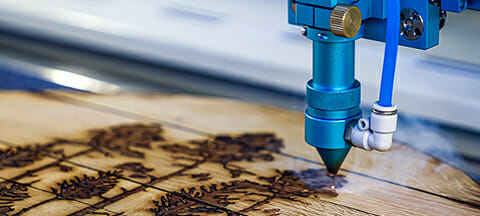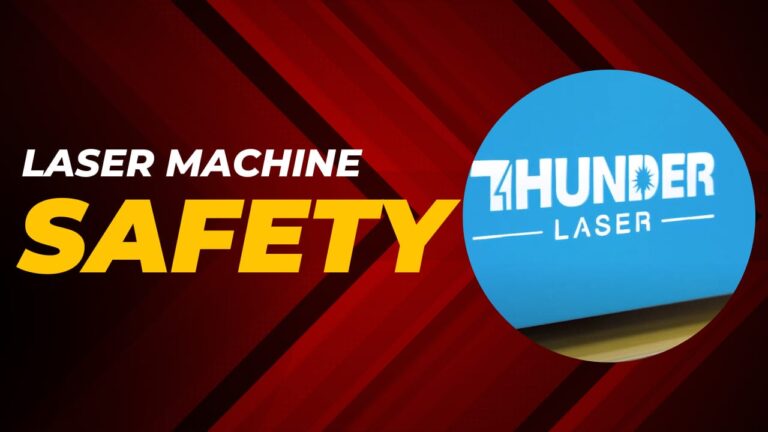Laser engraving machines are powerful and versatile tools that can produce stunning results. However, safety should always be a top priority when operating a laser engraving machine. The risks associated with operating a laser engraving machine can be severe. These risks range from eye damage to electrical hazards and fire risks. We’ll provide you with crucial safety tips and best practices to help you operate your laser engraving machine safely.
We’ve all heard of stories where people suffered severe injuries from using machinery without proper safety precautions. Just last month, a man was rushed to the hospital with severe eye damage after not wearing proper eye protection while using a laser engraving machine. Stories like this remind us of the importance of safety when operating any type of machinery, including laser engraving machines.
It’s essential to understand the potential risks associated with laser engraving, such as laser radiation and electrical hazards, to prevent accidents and injuries. While laser engraving machines come equipped with various safety features to protect operators, personal protective equipment (PPE) is also essential for safeguarding against potential hazards.
Operating a laser engraving machine in a cluttered or improperly ventilated workspace can also pose a risk of injury or damage. Proper workspace preparation, such as adequate lighting, ventilation, and cleanliness, is crucial for maintaining a safe and accident-free workspace.
Additionally, it’s vital to properly prepare materials for laser engraving and maintain the machine to ensure optimal performance and prevent accidents. By following the crucial safety tips and best practices outlined in this blog post, you can operate your laser engraving machine safely and confidently, without the fear of accidents or injuries.
Understanding Laser Engraving Safety
Laser engraving machines use powerful lasers to engrave and cut a wide variety of materials, including wood, plastic, and metal. While laser engraving can produce stunning results, it’s essential to understand the potential risks associated with operating a laser engraving machine.
Laser radiation is one of the most significant risks associated with laser engraving. Exposure to laser radiation can cause severe eye damage and skin burns. It’s crucial to wear appropriate eye protection when operating a laser engraving machine to protect against potential eye damage.
Electrical hazards are also a potential risk when operating a laser engraving machine. Laser engraving machines use high voltages to power the laser, and improper use or maintenance can result in electrical shock or fire hazards.
Fire risks are also a concern when operating a laser engraving machine. The intense heat generated by the laser can cause materials to ignite, resulting in fires or other types of damage. Proper ventilation and material preparation are crucial for preventing fires and ensuring a safe workspace.
To mitigate the risks associated with laser engraving, it’s essential to follow safety guidelines and best practices. Proper training, safety gear, and a thorough understanding of the risks associated with laser engraving are essential for operating a laser engraving machine safely.
By understanding the potential risks associated with laser engraving and following safety guidelines, you can create a safe and accident-free workspace. In the following sections, we’ll cover specific safety tips and best practices for operating a laser engraving machine safely and confidently.
Personal Protective Equipment
Personal protective equipment (PPE) is essential for protecting yourself from potential hazards when operating a laser engraving machine. PPE includes items such as safety glasses, gloves, and protective clothing, which help prevent injuries and keep operators safe.
One of the most crucial pieces of PPE for laser engraving is safety glasses. Safety glasses are designed to protect the eyes from laser radiation, which can cause severe eye damage. When selecting safety glasses, make sure they have the appropriate optical density rating for the laser being used.
Gloves are also essential for protecting the hands from potential hazards, such as electrical shock or chemical exposure. When selecting gloves, make sure they are made of the appropriate material for the task at hand and are not likely to get caught in moving parts.
In addition to safety glasses and gloves, protective clothing is also crucial for laser engraving safety. Protective clothing can include lab coats, aprons, and other types of clothing designed to protect the skin from laser radiation or other potential hazards. It’s essential to wear appropriate protective clothing to prevent potential injuries or damage.
When selecting PPE for laser engraving, it’s crucial to select items that are specifically designed for the task at hand. Generic safety equipment may not provide adequate protection from laser radiation or other hazards associated with laser engraving. Additionally, make sure that PPE is regularly inspected and maintained to ensure its effectiveness.
By properly selecting and utilizing PPE, you can protect yourself and others from potential hazards when operating a laser engraving machine. In the next section, we’ll cover additional safety tips and best practices for laser engraving to help you create a safe and accident-free workspace.
Machine Safety Features
Laser engraving machines come equipped with various safety features to protect operators from potential hazards. These safety features are designed to prevent accidents and injuries by halting the machine’s operation if an issue arises.
One of the most critical safety features of a laser engraving machine is the emergency stop button. The emergency stop button allows operators to immediately stop the machine’s operation in case of an emergency, such as a fire or a power outage. It’s crucial to ensure that the emergency stop button is easily accessible and functional at all times.
Interlocks are another essential safety feature of laser engraving machines. Interlocks prevent the machine from operating if a door or panel is open, which helps prevent accidents and injuries. Additionally, interlocks can help protect the machine from damage caused by improper use.
Door sensors are also crucial safety features for laser engraving machines. Additionally, door sensors detect when a door or panel is open and immediately stop the machine’s operation to prevent potential injuries or accidents. Door sensors can also help protect the machine from damage caused by improper use.
In addition to these safety features, some laser engraving machines come equipped with additional safety features, such as automatic shutdown systems and smoke detectors. These additional safety features can help prevent accidents and injuries by quickly detecting potential hazards and shutting down the machine’s operation.
It’s essential to regularly inspect and maintain the safety features of your laser engraving machine to ensure their effectiveness. Regular inspections can help identify any issues or malfunctions with the safety features and prevent potential accidents or injuries.
By properly utilizing and maintaining the safety features of your laser engraving machine, you can create a safe and accident-free workspace. In the following sections, we’ll cover additional safety tips and best practices for laser engraving to help you operate your machine safely and confidently.
Workspace Safety
Creating a safe workspace is crucial for laser engraving safety. A well-organized and clutter-free workspace not only promotes productivity but also minimizes potential hazards. In this section, we’ll provide tips for creating a safe workspace, including proper ventilation, adequate lighting, and a clutter-free environment.
Proper ventilation is essential for removing fumes and particulates generated during the laser engraving process. These fumes and particulates can be hazardous to health and can cause respiratory problems. A ventilation system that efficiently removes fumes and particulates can improve air quality and create a safer working environment. It is also essential to regularly check and maintain the ventilation system to ensure its effectiveness.
Adequate lighting is also essential for workspace safety. Poor lighting can lead to accidents and injuries, and can also impact the quality of the engravings. Ensure that your workspace has sufficient lighting, especially in areas where the laser engraving process is taking place. Bright lighting can help operators to see potential hazards and identify areas that require additional cleaning or maintenance.
Keeping a clutter-free workspace is also crucial for laser engraving safety. Ensure that the workspace is free from unnecessary items, and materials are stored correctly. When working with laser engraving machines, it’s essential to keep the workspace free of combustible materials and keep the area around the machine clear of debris.
Additionally, ensure that the workspace is equipped with appropriate fire extinguishers and that all operators know how to use them in case of an emergency. Regularly inspect fire extinguishers to ensure they are in good working condition and have not expired.
Minimize accidents and injuries by creating a safe workspace and following safety practices when operating a laser engraving machine. The next section will provide additional safety tips and best practices for confident and safe machine operation.
Proper Material Preparation
Proper material preparation is crucial for preventing accidents and producing high-quality engravings. The success of a laser engraving project largely depends on the materials used and how they are prepared. In this section, we’ll cover best practices for preparing materials for laser engraving, including selecting appropriate materials, securing materials, and using proper tooling.
Selecting appropriate materials for laser engraving is critical for achieving high-quality results. Not all materials are suitable for laser engraving, and some may emit hazardous fumes or pose a fire risk. It’s important to carefully select materials that are safe for laser engraving and that can withstand the engraving process without damaging the machine or the material itself. Always consult with the manufacturer’s guidelines for recommended materials.
Securing materials properly is another important aspect of material preparation. Improper material securing can cause shifting during engraving, resulting in inaccurate engravings or machine damage. Use clamps or adhesives to secure materials before engraving and ensure proper alignment and leveling.
Using proper tooling is also crucial for proper material preparation. Different materials require different tools and settings to achieve the best results. For example, materials such as wood may require a lower power setting, while metals may require a higher power setting. Additionally, using the correct lens can affect the quality of the engraving. It’s essential to understand the specific needs of each material and adjust the settings accordingly.
In addition to selecting appropriate materials, securing materials, and using proper tooling, it’s also essential to inspect materials for potential hazards before beginning the engraving process. Remove any stickers, tape, or other debris that may pose a risk to the machine or the operator.
Achieve accurate, high-quality engravings by following material preparation best practices. Minimize accidents and machine damage. The next section covers safety tips and best practices for confident laser engraving.
Proper Maintenance and Inspection
Proper maintenance and inspection are crucial for ensuring the safe and efficient operation of your laser engraving machine. Regular maintenance prevents accidents and extends machine life, while inspection identifies potential issues early. This section offers tips for machine maintenance and inspection, such as cleaning, checking for wear and damage, and following the manufacturer’s schedule.
Regular cleaning is an essential aspect of laser engraving machine maintenance. Debris buildup can affect the quality of engravings and even damage the machine. Use a soft cloth or brush to remove any dust or debris from the lens, mirrors, and other components. Avoid using harsh chemicals or abrasive materials that could damage the machine. Regular cleaning can also help prevent fires caused by debris buildup.
Checking for wear and damage is also crucial for maintaining your laser engraving machine. Over time, parts of the machine can become worn or damaged, affecting its performance and safety. Regularly inspect your machine for signs of wear or damage, such as frayed belts or worn bearings. Replace any worn or damaged parts promptly to prevent further damage and ensure optimal performance.
Following the manufacturer’s recommended maintenance schedule is also essential for prolonging the life of your laser engraving machine. The manufacturer’s guidelines will provide information on how often to perform routine maintenance tasks, such as replacing filters or lubricating moving parts. Adhering to the recommended maintenance schedule can help prevent major breakdowns and ensure the machine is operating safely and efficiently.
In addition to regular maintenance, it’s also important to conduct regular inspections of the machine. These inspections should include checking for loose or missing parts, inspecting electrical connections, and testing the safety features. By conducting regular inspections, you can identify potential issues before they become major problems and take corrective action to prevent accidents.
By following these tips for proper maintenance and inspection, you can ensure that your laser engraving machine is operating safely and efficiently. In the next section, we’ll cover additional tips for safe and effective laser engraving.
Conclusion
Laser engraving can be a rewarding and profitable endeavor, but safety should always be a top priority. By following the crucial safety tips and best practices outlined in this blog post, you can operate your laser engraving machine safely and produce stunning results.




